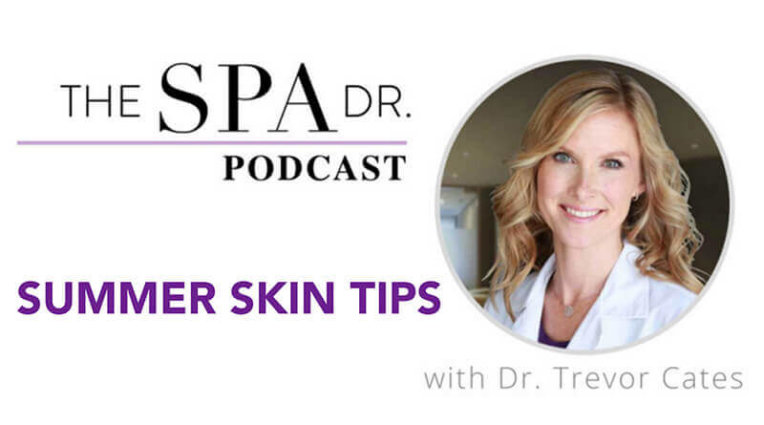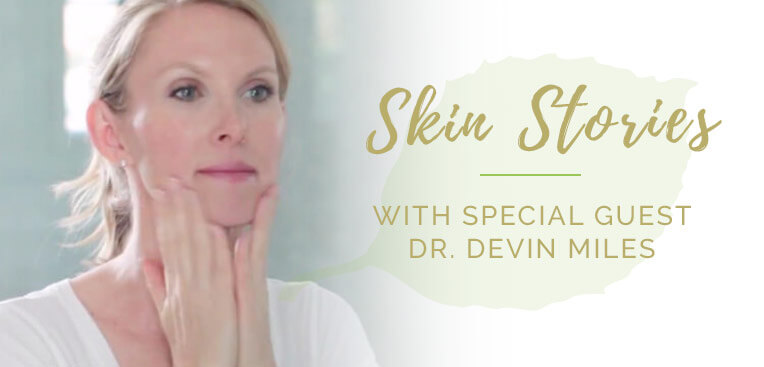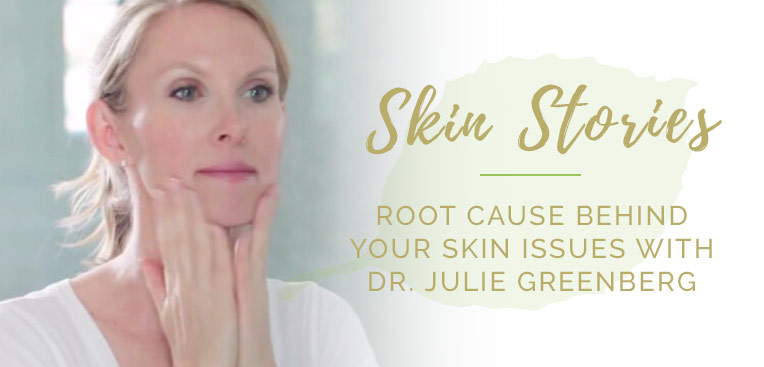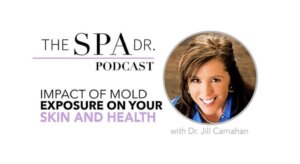Today, Dr. Cates shares her top skin care tips to keep your skin glowing and healthy throughout the summer. Discover inner and outer nourishment secrets to keep your body hydrated and protected, even on hot sunny days. Dr. Cates covers examples of specific dietary changes to make as well as sunblock, sunburn and dry skin tips.
Dr. Trevor Cates is author of the newly released bestselling book Clean Skin From Within. She is also known, as “The Spa Dr.” and was the first woman licensed as a naturopathic doctor in the state of California, appointed by former Governor Arnold Schwarzenegger to California’s Bureau of Naturopathic Medicine Advisory Council. Dr. Cates has her own Public Television special, “Younger Skin From Within” and is host of The Spa Dr. Podcast.
Find more tips for glowing skin from Dr. Cates in her book Clean Skin From Within.
Like this podcast? Go to iTunes and leave a review to help inspire others to tune in.
If you have not done so already, I highly recommend that you get your customized skin profile at here. It’s free and based upon your answers, it will give you great tips for glowing skin and vibrant health. Also don’t miss out on all of the latest tips to get glowing skin and vibrant health, be sure to follow me on Facebook, Pinterest and Twitter. And join the conversation!
Thank you, and we’ll see you next time on The Spa Dr. Podcast.
TRANSCRIPTION
Trevor Cates: Hi there. I’m Dr. Trevor Cates. Welcome to The Spa Dr. Podcast. Today I want to share with you some summer skin care tips, so that you can continue to have that natural, healthy glow throughout the summer. I know that there are some concerns about your exposure to the sun and the damage that occurs, so I want to talk to you about various things. I’m going to be talking about sunscreens and sunblocks, what to look for, what to avoid, how to use them, and what SPF you should be using, all those kinds of tips, as well as how much sun exposure you still want to be getting in order to get some good vitamin D. I’ll be sharing foods and drinks, internal nourishment, that you can be getting that will help support your skin, keep it healthy from the inside out, as well as external skin care tips and what you should be doing in the summer months to really help support your skin and what you could be doing for things like bee stings and sunburns. I hope you enjoy this information today.
Today I want to share with you some summer skin care tips. I think this is going to be helpful for you, because I know it’s summertime right now. I know it can be overwhelming sometimes with the amount of information out there on skin care, and summer’s no different than that. We want to protect our skin during the summer months, because we do get a lot of extra sun exposure and the weather changes, whether that’s dryness or humidity, depending upon where you live or where you’re traveling. I want to share some tips for you to help you have a healthy glow during the summer months.
With my approach to skin care, I really like to use a two-part approach. That’s inner and outer nourishment. I’m going to cover both of those today and just go over some of this. For inner nourishment, let’s start there. When I talk about inner nourishment, a lot of what I’m talking about is what you’re eating, what you’re consuming, things you’re doing internally, to help support and nourish your body from the inside out. During the summer, we oftentimes get dehydrated from being out in the sun, and it’s hot, and we’re perspiring.
The first thing is to keep in mind is to make sure that you’re staying hydrated. You want to drink plenty of water, and I also really like, in addition to drinking purified water, I also really like coconut water, because coconut water naturally has lots of great electrolytes in it. The best way to get coconut water is to get a fresh coconut and cut it open, or get one of those little devices. You can poke a hole in it, put a straw in it, and drink fresh coconut. It’s so delicious, so hydrating. You don’t really need to drink more than one of those a day. Certainly there is still some naturally occurring sugar in those, so you don’t want to overdo it. If you do buy store-bought, just make sure it doesn’t have anything added to it, no added sugar or flavoring, artificial ingredients, any of those kinds of things. Keep it simple.
Then if you’re not a big fan of water, maybe you can’t get the coconut water, herbal iced teas are another option. Just keep in mind that some herbal teas, they work as diuretics. That, just like caffeine, so regular iced tea would be similar in that with a diuretic, it’s going to cause you to actually lose more water. You want to choose herbal teas that are more hydrating rather than ones that are diuretics. Something refreshing like one of my favorites is to use red tea or rooibos tea, and turn that into an iced tea.
Also you want to stay … and we’re talking along the drinks line. You want to stay away from the sugary drinks. I know it’s tempting, it’s confusing, it’s hard to understand. What are healthy drinks, and what are not? A lot of the drinks that are made out there are full of sugar. Even though they say they have natural ingredients, no added sugar, if it has fruit juice, maybe it’s like a smoothie in a container and a bottle, a lot of times the sugar starts to add up with those because of all the fruit in there. It’s good to just take a look at the ingredients and also the nutrition facts, and see how much sugar is actually in it. It might be surprising to you to find out that when you get some of these smoothies in a bottle, pre-made smoothies or drinks, that there can actually be more sugar in those than a soda. Of course, sodas are loaded with sugar.
Now I also want to say, it’s not going to be a better alternative to go with the diet drinks, because the artificial sweeteners are just … I think they’re worse than regular sugars. They come with a whole host of other problems. Any time of year, you don’t want to be doing those either, but just keep in mind that you want to stay away from the sugary drinks, and choose ones like herbal iced tea, coconut water, water. Those are fantastic alternatives. If you want something with a little sweetness, you could choose ones that are sweetened with stevia or erythritol, those kinds of things, so that they’re not going to cause your blood sugar to increase, because the last thing you want to do is create this pro-inflammatory state that sugar causes that’s going to further inflame skin conditions that often already worsen during the summer, because with the heatness … Sorry, the heatness, the redness worsens during heat.
In times of heat and humidity, your skin tends to be inflamed or red. That can worsen during the summer months, so you want to do things that are anti-inflammatory instead of pro-inflammatory. Sugar is one of those pro-inflammatory foods that we really want to watch out for. Also, when we eat a lot of sugar, it increases our blood sugar, which then can create glycation issues in the body and really speeds up the aging process. Really, any time of year, we want to be careful with glycation, but during the summer months when our skin is getting that extra sun exposure, we want to be particularly careful.
Also, to help keeping from being dehydrated, you want to limit your intake of caffeine. If you do have caffeine, whether that’s black tea, iced tea, hot tea, coffee, any of those kinds of things, then if you do have a little bit of that, you want to make sure you’re drinking extra water so that you can get the hydration that you need.
Also, one of the things that sometimes people do a lot in the summer is barbecuing. I know, Americans, we love our barbecues, but I do want you to keep in mind that when we heat meat on a grill at a high temperature, it does cause changes in the animal protein that can make it actually carcinogenic and also cause more of these glycation issues that speed up the aging process. Just limit your barbecues. I’m not saying don’t do any of them, but just try not to overcook the meat and don’t … Maybe not barbecue every single night.
Here’s one of the great tips that I want to share with you is add vegetables to the barbecue. A lot of times, people just immediately throw the meat on, but if you do like sliced, grilled zucchini or mushrooms, you could get the big portabello mushrooms, so those sorts of things, you can put those on the grill. They don’t actually have that same kind of effect of causing the glycation issues and carcinogenic properties. As long as you’re not blackening them, they’re still going to contain a lot of the nutrients and get a lot of the benefits from that. It may be able to help counterbalance some of the downsides of getting the meat on the barbecue.
All right, so also, along those lines, we want to get extra antioxidants during the summer. We get a lot of oxidative damage in the summer because of the exposure of our skin to the sun. Being out in the sun creates oxidative damage. Also, we just get oxidative damage from being exposed to pollution, environmental pollutants, year round, so we always want to be consuming antioxidants. But in the summer, it’s great to get extra of those, and it’s so much easier to get them because everything is growing like crazy in the summer.
It’s so great to go to the farmer’s market, pick up some fresh, colorful fruits and vegetables. Figure out what’s in season at the time when you go to the farmer’s market. Try and get organic and local as much as possible. I love that. Berries are fantastic, high in antioxidants. Also veggies, you could get lots of greens and include those in your diet. Legumes also can have antioxidants, so like black beans, you could make black bean salad. I’ve got some recipes in my book, Clean Skin from Within, that include black beans, one of my favorites of the legumes. Also, peas also contain antioxidants. Think about ways you could start incorporating more of these.
Also, wild Alaskan salmon is another great way to get antioxidants. You get that antioxidant astaxanthin. Astaxanthin is one of my favorite antioxidants for summer months, because astaxanthin works like … almost like it works like it protects the skin from the inside out from sun damage. I’m not saying it’s going to work the same as a sunblock would, but it’s going to help add some extra protection for you when you’re out in the sun. Get some wild salmon in your diet. If you don’t like salmon, you could also take it as a supplement. I do have the krill, Astaxanthin + Omega Krill, supplement at The Spa Dr. There’s great alternatives you could take in supplement form if you don’t like to actually eat salmon, although I’d like for you to kind of give it a try, because it is a great food for the skin.
Then that kind of takes me to taking supplements. You might want to consider taking supplements to add to the antioxidant protective qualities that you can get from taking supplements that are going to protect your skin from the inside out. One of my favorites is taking vitamin C. Especially in the summertime, there’s something really refreshing about the vitamin C fizz powder or other vitamin C drinks that you can get. I know we have it at The Spa Dr., but you can find it other places too. Having extra vitamin C is refreshing. You can also get vitamin C in your food from citrus, from strawberries, broccoli, lots of great produce out there.
If you freshly squeeze juices, then that can be great, but just keep in mind that, with vitamin C, you don’t want to be drinking lots of the boxed-up orange juice. That’s not going to be a great source of vitamin C, because when it’s been sitting around, the vitamin C dissipates pretty quickly, so it doesn’t hang around in the juice as much as if you were to get it freshly squeezed. Also, what you end up with is with a lot of sugar when you just drink boxed orange juice. Other great sources of vitamin C, again strawberries, broccoli, kale. There are lots of great other options out there.
Let’s now take a shift and move over to externally what you can do to protect your skin in the summer months. As you know, we get a lot more sun exposure in the summer, so the most important time to be careful is the peak times of the day. The middle of the day is when the sun at its highest. It’s the peak rays. It’s when you’re more prone to getting the most sun damage. Try and limit your exposure in the middle of the day, and make sure that you’re protecting your skin if you do go in the sun during those times.
It is good to get some sun exposure without using sunblock. I’m going to talk about sunscreens, sunblocks, in just a moment, but I first wanted to talk about the importance of vitamin D, because we … Vitamin D is actually a hormone, and our body makes it. When our skin is exposed to the sun, it makes vitamin D in our skin. We need vitamin D for our immune system, for our bones, for a lot of different things for our health. We make vitamin D, and we make more of it in the summer months when we’re exposed to the sun. Then our body stores it up over the winter months. That’s one of the reasons why it’s still good to get some sun exposure, so you could get your vitamin D stores built up, but you don’t actually need a lot of sun exposure to get the vitamin D.
Here’s the thing about vitamin D. I think it’s really good to get your vitamin D levels tested. When you go get your blood work done, next time you go see your doctor, just ask them to add this lab test on to your lab work. It’s called a 25-hydroxy vitamin D. The doctor can add that on and you’ll know what your vitamin D levels are. Now here’s the other thing about that is you want your levels to be sort of mid-range or on the upper end of the normal range, because if it’s on the low-normal side, that still means you’re going to be a little too low for what I like to see for optimal health.
If your vitamin D levels are low or they’re low-normal, then I would suggest taking a vitamin D supplement, and you want to take it as a vitamin D3 supplement. If your vitamin D levels are normal or high-normal, then you could just get some sun exposure and get foods that are high in vitamin D, like certain types of mushrooms actually. Shiitake mushrooms, for example, are high in vitamin D, cod liver oil, salmon. There are some foods that actually contain it.
Let’s get back to the sun. The amount of sun exposure that you need to get vitamin D really depends on a few different factors. It depends upon your location, so if you’re … I live in Park City, Utah, so I’m actually high elevation. I don’t need as much sun exposure, because I’m actually closer to the sun. It also depends on how far you are from the equator. If you’re closer to the equator, you don’t need as much sun exposure to get vitamin D. Then also your skin color, your skin pigmentation. I’m very fair-skinned, so I don’t need as much sun exposure to get vitamin D as someone who has darker skin. They’re going to need a little bit more sun exposure. There are some other factors, like age and things like that, but those are the main things to think about.
In general though, what I recommend is getting exposure on … You can use your arms and legs as the best place to get sun exposure to get vitamin D. Go ahead and cover up your face and the tops of your hands, because that’s where you get the most sun exposure year-round. That’s what’s going to age the fastest. That’s where we’re going to see the most fine lines, wrinkles, hyperpigmentation, those kinds of changes, so those are the areas you want to focus on protecting all the time. But when you cover up with sunblock or sunscreen, your body can’t make vitamin D, so go ahead and give yourself, your skin, your arms and legs, some chance to get some exposed, no sunscreen on, just a few times a week, non-peak hours of the day, really only needs to be like 10 to 15 minutes a day. Now if you want to get a little bit more than that, then that’s good too, but the rest of the time is just bonus.
That’s what you really … all you need to get the vitamin D. Again, if you are deficient, then you want to take a supplement, not just try and get a ton more sun exposure, because you can get damage from getting too much sun exposure. I want you to get out, get out in nature, enjoy the outdoors. There’s so much benefit of that, of being out in nature, and breathing the fresh air and enjoying the endorphin release of the excitement of being out and being active in the outdoors. Just be smart about it. Wear hats. Wear sunglasses. Get some time in the shade. Avoid the peak hours as much as possible. Use some cover-ups. Try to cover up your skin so that you’re not getting sunburned or getting too much sun exposure.
Now let’s talk about sunscreens, because this is something that I feel like a lot of people make mistakes here. Unfortunately a lot of the … Most of the sunscreens on the market have a lot of harmful chemicals in them. There are a lot of hormone-disrupting chemicals, they’re also called endocrine-disrupting chemicals, that are in popular sunblocks or sunscreens. I’ll give you an example. One of the ingredients to look for is oxybenzone, and oxybenzone is a known endocrine-disrupting chemical and those hormone-disrupting chemicals. It’s in the majority of the sunscreens out there. We do know that we can get absorbed, these things can get absorbed in our skin.
We know endocrine-disrupting chemicals, we’re exposed to them in so many different places in our air, in our water, in our food, in our personal care products, so we want to do what we can to reduce our exposure to these chemicals. The hormone-disrupting effects, the endocrine-disrupting chemicals, have been linked to thyroid disease, certain types of cancer like breast cancer, prostate cancer. They’ve also been linked to infertility, obesity, and the list goes on and on. We want to be careful with endocrine-disrupting chemicals. Oxybenzone has been identified as a hormone-disrupting chemical. What exactly it does in the body, we still don’t know, but we do know it has hormone-disrupting effects. Then some of the other chemical sunscreens, ingredients have also been linked to hormone-disrupting effects. Some of those science and the labs have been … The reports have been done on animals, and some on humans, but we do need more information on this.
In the meantime, what my recommendation is is to shift away from those chemical sunscreens to sunblocks that contain zinc oxide. They work differently. When you apply chemical sunscreen like oxybenzone and a lot of the chemical ingredients you’ll see, if you apply those on the skin, they cause a chemical reaction in your skin. That’s what causes the SPF which causes the sun protection to occur. Zinc oxide and some of the other mineral sunblock ingredients actually create a physical barrier. That’s another reason why they’ll look kind of pasty. The good news is about zinc oxide is there’s better technology now so that the particle size has been reduced. You can now find zinc oxide sunblocks that go on easier, so you’re not going to have that thick, pasty feeling.
Now they’re always going to feel a little different, even the better-made ones. They’re going to feel a little different than the chemical ones, but I think you’ll get used to it. Still you want to use the SPF around 30. That’s a good place for face and body. If you’re not going out in the sun very much, you’re just getting a little bit, then maybe 15 SPF is fine. Anything higher than a 30 might be more marketing hype than anything. It’s hard to know, but you want to at least get an SPF of 30. If it says it’s over 30, then you probably know it’s at least 30. That’s a good place to go.
What you do want to avoid are the spray sunblocks and sunscreens, and here’s why. I know some of you are going to hate me for saying this, because I know they’re so easy, especially with kids when you have the sprays. Maybe just being aware of this will help you be safer if you do choose to use them, is that when you spray the sunblocks, they get into the air. You and your family can actually breathe those particles in. When we’re talking about the chemical sunscreens, we’re talking about those hormone-disrupting chemicals.
When we’re talking about these mineral sunblocks, some of these mineral sunblocks are in these tiny, tiny, little particles. If you know they’re in the micronized or nano-sized tiny particles, the concern is that we can actually breathe those in and they get inside lung tissue and create inflammation. We want to be careful, so if you do choose to use a spray, you might want to wear a mask or just make sure you’re holding your breath, and your family, your kids, whoever is getting it put on, holding your breath when you do it, or you can try and do it away from your face. Just be careful with that.
Same thing goes with powders, so women, you might be using mineral makeups which are great to use, because they do provide some sun protection. You may not be aware that when you’re using powders, that again it’s going into the air around you. If it’s in these tiny, little particles, then you could breathe it in, and it could get trapped inside the lung tissue. There are some tips on that.
Another tip on the zinc oxide that I really, really like for summertime is to use the tinted sunblocks. Use the tinted zinc oxide sunblocks, because they’re already kind of white anyway. When you get them tinted, you can pick your skin tone, and you use that. For women, you’ll find that it’s a really nice substitute to using foundation. Foundation, liquid makeup that you’re using on your face, is tougher in the summer months because it’s hot, it’s humid, you’re perspiring more. That could cause you to break out more. It’s tougher on your skin, your skin cell turnover.
Using a tinted sunblock could be a nice alternative. It’s going to be lighter on your skin. I do prefer to avoid using the ones that contain dimethicone, because that is one ingredient that does tend to trap moisture under the skin. It can make your skin feel good when it first goes on, but once you get out and you’re exercising and you’re hot, then it can create sort of like this barrier on your skin that could potentially cause your skin to flush or maybe even alter the skin microbiome, so some things to think about with that.
Okay, so if you do go in the sun and you get a little too much, make sure that you use aloe on your skin afterwards and moisturize your skin really well. Of course, you want to use clean, non-toxic skin care products and ingredients, but if you use ones that contain aloe, that could be a great way to nourish the skin. It can help repair the damage from that excess sun exposure. You can get an aloe plant, and just take the leaves, open them up, and squeeze the inside out. Use that gel-like stuff on the area of the sunburn, and use it directly on the skin. It’s really nice to use it that way. You can also get straight aloe gel from a store. Just make sure it doesn’t have any other ingredients added to it. It’s really hard to find a pure aloe gel that doesn’t have colors and the fragrance and all of that stuff. You could also find skin care products that contain aloe. My skin care line, The Spa Dr.’s Daily Essentials and our exfoliant, do contain aloe. That’s a nice alternative.
Okay, that moves me on to other things that you can do for your skin during the summer months. One of the things that’s really great for your skin in the summer, a lot of times going into summer, our skin tends to be dull and dry. You might be noticing more lines, fine lines. One of the things that’s really great to help with all of that is to use good exfoliation. Using a good exfoliant is key, because it’s going to help remove the dead surface of your face and your body. If you want to do exfoliation all over your body, that’s great too. I’m particularly talking about the face.
When you exfoliate, once or twice a week is usually all people need, but it’s also going to help the other skin care products that you use. It’s going to help them penetrate better, work better the way they’re supposed to. It’s best to do it in the evening, so that you’re not doing it right before you go out in the sun. It gives your skin a chance to be soothed by your other products overnight, and then be ready in the morning. Like I said, I generally recommend it one to two times a week for a good exfoliant. You want to be careful not to use anything too abrasive. A lot of the exfoliants on the market have chemical, harmful ingredients, so you definitely want to avoid those. They also have really rough exfoliating properties, or the enzymes that are used can be really intense.
You want to be careful about the products you use, using tiny little particles. If you’re using a mechanical or physical exfoliant, it needs to be very small. We just released an exfoliant at The Spa Dr., and we used a cultured freshwater pearl. We’re very careful about the ingredients that are in our product, and we wanted to get the cultured freshwater pearl, because we’re sure that it’s not going to contain any impurities. It’s going to be really smooth, and we have it ground to a very, very small particle size, so that it’s not going to damage your skin, because a lot of these exfoliating products with these big particles are actually going to damage your skin. That’s the last thing you want to do. You just want to remove the dead skin off the surface.
When you do it, once or twice a week. If you have sensitive skin, I would say do it once a week. Most people could do twice a week. Just make sure that you’re not only just doing your face, but also your chest and your neck. You could do the tops of your hands, and you could also do your lips, which is kind of a nice thing. In the summertime, sometimes we tend to get dry lips. It could be a good thing to do. Hopefully that gives you some good tips for exfoliation. You don’t need to use a lot of pressure with it. Just lightly caressing the skin with a good exfoliation, doing that once or twice a week at night, it will be great. Then [inaudible 00:28:18], you can finish off your skin care routine with moisturizing. Again, I recommend doing it at night, but if you happen to do it in the morning, then you would just apply your sunblock after that.
That does bring me to going back to the sunblock. People ask me, “So when do I apply the sunblock with the rest of my skin care routine?” I do recommend putting on sunblock after you have cleansed, put your serum, toners, moisturizers all that on. Put the sunblock on over top of that. If you’re wearing makeup, put makeup on first and then put the sunblock ideally. Sometimes it’s hard to do that, but again, that’s why I like to use the tinted sunblock, because then that’s part of your makeup if you’re wearing makeup.
You can also get some extra hydration by doing some masks, face masks, and getting some extra hydration for that. It also can be great for soothing skin that might be inflamed and irritated during the summertime. There are lots of great do-it-yourself skin care recipes for masks, and my book, [inaudible 00:29:27], on page 186, I think I have … 186, I have a turmeric chickpea face mask that can be really nice and soothing to the skin. If you have really fair skin, don’t leave it on a long time, because turmeric can stain the skin. I use it and I’ve left it on for 10 minutes, and it doesn’t stain my skin. I have fair skin. But if you have super fair skin, something to keep in mind on that one. Turmeric is such a powerful antioxidant too that it helps kind of curb that oxidative damage that might be occurring from that excess sun exposure.
Then when it comes to externally, other things to think about, what other personal care products are you using in the summer? A lot of people, in addition to the sunblocks, they’re also using bug repellents, insect repellents, on their bodies, because of mosquitoes and ticks and all that. Be careful about those, because there are a lot of harmful ingredients in those as well. There can be hormone-disrupting chemicals in those. Instead, look for natural ones, because there’s some nice, natural alternatives to bug repellents that contain essential oils. That’s a great alternative. There’s some nice ones available. Just look for those in your local health food store or online.
It makes a nice alternative, because one of the worst combinations really of the chemical combination is a chemical sunscreen with a chemical bug repellent added together. Here people are camping. They’re at the lake, at the pool, and they’re putting both of those things on. They’re putting them on their kids. It really concerns me when I see that, because the chemical reactions that are happening there are not good for our health. Just keep in mind that what you put on your kids if you have kids, just remember that they’re smaller. Their organs are developing. They’re more susceptible to these chemicals than even we are. You want to be particularly careful with the kind of sunblocks and bug repellents and those sorts of things that you’re putting on your kids.
There are lots of great, natural tips also for things like insect bites and poison ivy, poison oak, lots of those options out there. When you’re choosing your personal care products and your first aid cabinet for the summer, just keep in mind keep it natural. Keep it clean. There are so many great alternatives out there now. If your kid, for example, gets, or you gets, an insect bite, maybe a bee sting, for example, you can run in the kitchen, grab some baking soda, and put it in your palm, pour a little bit in your palm. Add just enough water to make it into a paste, and use that directly on the bee sting. It immediately will help have a soothing effect. Of course, if you or your child needs medical attention, you want to go and get that.
I hope this has given you some good tips today for your summer skin care. Just as a recap, remember it really comes both internally and externally, so doing things, what you’re eating, what you’re doing internally to nourish and protect your skin like consuming antioxidant-rich foods, hydrating your body from the inside out, and then externally also nourishing and protecting your skin on the outside. I hope you have a wonderful summer, and that your skin is glowing, and that these tips have been helpful for you. I’ll see you next time. Thanks for joining me.








Reader Interactions